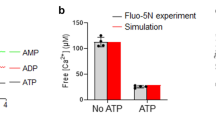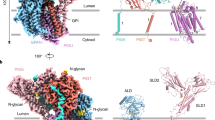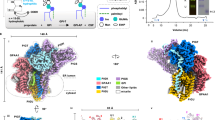Abstract
The release of neurotransmitter is regulated in the processes of membrane docking and membrane fusion between synaptic vesicles and presynaptic plasma membranes. Synaptic vesicles contain a diverse set of proteins that participate in these processes. Small GTP-binding proteins exist in the synaptic vesicles and are suggested to play roles for the regulation of neurotransmitter release. We have examined a possible role of GTP-binding proteins in the regulation of protein phosphorylation in the synaptic vesicles. GTPγS stimulated the phosphorylation of 46 kDa protein (p46) with pI value of 5.0-5.2, but GDPβS did not. The p46 was identified as protein interacting with C-kinase 1 (PICK-1) by MALDI-TOF mass spectroscopy analysis, and anti-PICK-1 antibody recognized the p46 spot on 2-dimensional gel electrophoresis. Rab guanine nucleotide dissociation inhibitor (RabGDI), which dissociates Rab proteins from SVs, did not affect phosphorylation of p46. Ca2+/ calmodulin (CaM), which causes the small GTP- binding proteins like Rab3A and RalA to dissociate from the membranes and stimulates CaM- dependnet protein kinase(s) and phosphatase, strongly stimulate the phosphorylation of p46 in the presence of cyclosporin A and cyclophylin. However, RhoGDI, which dissociates Rho proteins from membranes, reduced the phosphorylation of p46 to the extent of about 50%. These results support that p46 was PICK-1, and its phosphorylation was stimulated by GTP and Ca2+/CaM directly or indirectly through GTP-binding protein(s) and Ca2+/CaM effector protein(s). The phosphorylation of p46 (PICK-1) by GTP and Ca2+/CaM may be important for the regulation of transporters and neurosecretion.
Similar content being viewed by others
Article PDF
Author information
Authors and Affiliations
Rights and permissions
This is an Open Access article distributed under the terms of the Creative Commons Attribution Non-Commercial License (http://creativecommons.org/licenses/by-nc/3.0/) which permits unrestricted non-commercial use, distribution, and reproduction in any medium, provided the original work is properly cited.
About this article
Cite this article
Kim, AR., Choi, WH., Lee, SR. et al. Phosphorylation of 46-kDa protein of synaptic vesicle membranes is stimulated by GTP and Ca2+/calmodulin. Exp Mol Med 34, 434–443 (2002). https://doi.org/10.1038/emm.2002.61
Published:
Issue date:
DOI: https://doi.org/10.1038/emm.2002.61
Keywords
This article is cited by
-
Rod bipolar cells dysfunction occurs before ganglion cells loss in excitotoxin-damaged mouse retina
Cell Death & Disease (2019)
-
Making protein interactions druggable: targeting PDZ domains
Nature Reviews Drug Discovery (2004)



